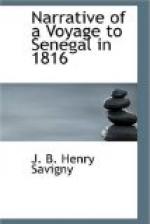The western arm of the river is separated from the sea by a point called the Point of Barbary. It is inconceivable how this slip of land, which is not above 250 metres in its greatest breadth, and is formed only of sand, should be able to resist the efforts of the river, which always tends to destroy it; and those of the sea, which breaks upon it sometimes with such fury, that it covers it entirely, and even crossing the arm of the river, comes and breaks on the shore of the island of St. Louis. Almost opposite the chateau and on the Point of Barbary, is a little battery of six guns at the most, which is called the Fort of Guetander; it is on the summit of a hill of sand which has been formed by the wind, and increases daily; it is even already pretty high, and is surrounded by a great number of huts of the blacks, which form a pretty extensive village: these buts tend to hold the sand together, and to prevent its sinking. The inhabitants of this village are very superstitious, as the following anecdote will prove.
In the course of the month of September, Messrs. Kummer and Correard crossed the arm of the river, to visit the coast of Barbary and the village of Guetander; when they landed on the point, they proceeded towards the north, and having gone three or four hundred paces along the shore, they found a turtle, the diameter of which was a metre at the least; it was turned upon its back and covered with a prodigious quantity of crabs, (toulouroux)[61] which are found along the sea-coast. Mr. Correard stopped a moment, and remarked that, when he had wounded one of these animals with his cane, the others devoured it instantly. While he was looking at these crabs feeding on the turtle, Mr. Kummer went on towards the south, and visited the burying-places of the blacks. Mr. Correard joined him, and they saw that the natives erect over the tombs of their fathers, their relations and friends, little sepulchres, some made of straw, some of slight pieces of wood, and even of bones. All these frail monuments are consecrated much more by gratitude than by vanity. The blacks prohibit all approach to them in the strictest manner. Mr. Kummer, whom his companion had left to return to the shore, was examining very tranquilly these rustic tombs, when suddenly one of the Africans armed with a sabre, advanced towards him, crouching and endeavouring to surprise him; Mr. Kummer had no doubt but this man had a design upon his life, and retired




